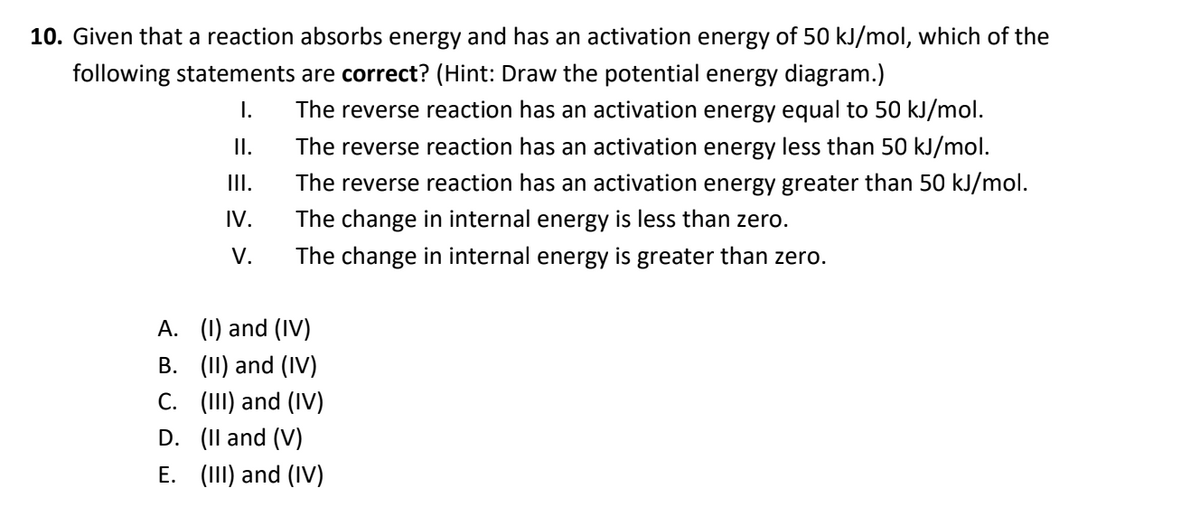Given that a reaction absorbs energy and has an activation energy of 50 kJ/mol, which of the following statements are correct? (Hint: Draw the potential energy diagram.) I. The reverse reaction has an activation energy equal to 50 kJ/mol. II. The reverse reaction has an activation energy less than 50 kJ/mol. III. The reverse reaction has an activation energy greater than 50 kJ/mol. IV. The change in internal energy is less than zero. V. The change in internal energy is greater than zero. A. (1) and (IV) В. (1) and (IV) C. (III) and (IV) D. (II and (V) E. (III) and (IV)
Given that a reaction absorbs energy and has an activation energy of 50 kJ/mol, which of the following statements are correct? (Hint: Draw the potential energy diagram.) I. The reverse reaction has an activation energy equal to 50 kJ/mol. II. The reverse reaction has an activation energy less than 50 kJ/mol. III. The reverse reaction has an activation energy greater than 50 kJ/mol. IV. The change in internal energy is less than zero. V. The change in internal energy is greater than zero. A. (1) and (IV) В. (1) and (IV) C. (III) and (IV) D. (II and (V) E. (III) and (IV)
General Chemistry - Standalone book (MindTap Course List)
11th Edition
ISBN:9781305580343
Author:Steven D. Gammon, Ebbing, Darrell Ebbing, Steven D., Darrell; Gammon, Darrell Ebbing; Steven D. Gammon, Darrell D.; Gammon, Ebbing; Steven D. Gammon; Darrell
Publisher:Steven D. Gammon, Ebbing, Darrell Ebbing, Steven D., Darrell; Gammon, Darrell Ebbing; Steven D. Gammon, Darrell D.; Gammon, Ebbing; Steven D. Gammon; Darrell
Chapter13: Rates Of Reaction
Section: Chapter Questions
Problem 13.126QP
Related questions
Question
#6 Q10

Transcribed Image Text:10. Given that a reaction absorbs energy and has an activation energy of 50 kJ/mol, which of the
following statements are correct? (Hint: Draw the potential energy diagram.)
I.
The reverse reaction has an activation energy equal to 50 kJ/mol.
I.
The reverse reaction has an activation energy less than 50 kJ/mol.
II.
The reverse reaction has an activation energy greater than 50 kJ/mol.
IV.
The change in internal energy is less than zero.
V.
The change in internal energy is greater than zero.
A. (1) and (IV)
B. (II) and (IV)
C. (II) and (IV)
D. (Il and (V)
E. (III) and (IV)
Expert Solution
This question has been solved!
Explore an expertly crafted, step-by-step solution for a thorough understanding of key concepts.
This is a popular solution!
Trending now
This is a popular solution!
Step by step
Solved in 3 steps with 1 images

Knowledge Booster
Learn more about
Need a deep-dive on the concept behind this application? Look no further. Learn more about this topic, chemistry and related others by exploring similar questions and additional content below.Recommended textbooks for you

General Chemistry - Standalone book (MindTap Cour…
Chemistry
ISBN:
9781305580343
Author:
Steven D. Gammon, Ebbing, Darrell Ebbing, Steven D., Darrell; Gammon, Darrell Ebbing; Steven D. Gammon, Darrell D.; Gammon, Ebbing; Steven D. Gammon; Darrell
Publisher:
Cengage Learning

Chemistry: The Molecular Science
Chemistry
ISBN:
9781285199047
Author:
John W. Moore, Conrad L. Stanitski
Publisher:
Cengage Learning

Introductory Chemistry: A Foundation
Chemistry
ISBN:
9781337399425
Author:
Steven S. Zumdahl, Donald J. DeCoste
Publisher:
Cengage Learning

General Chemistry - Standalone book (MindTap Cour…
Chemistry
ISBN:
9781305580343
Author:
Steven D. Gammon, Ebbing, Darrell Ebbing, Steven D., Darrell; Gammon, Darrell Ebbing; Steven D. Gammon, Darrell D.; Gammon, Ebbing; Steven D. Gammon; Darrell
Publisher:
Cengage Learning

Chemistry: The Molecular Science
Chemistry
ISBN:
9781285199047
Author:
John W. Moore, Conrad L. Stanitski
Publisher:
Cengage Learning

Introductory Chemistry: A Foundation
Chemistry
ISBN:
9781337399425
Author:
Steven S. Zumdahl, Donald J. DeCoste
Publisher:
Cengage Learning


Chemistry
Chemistry
ISBN:
9781305957404
Author:
Steven S. Zumdahl, Susan A. Zumdahl, Donald J. DeCoste
Publisher:
Cengage Learning

Chemistry for Engineering Students
Chemistry
ISBN:
9781337398909
Author:
Lawrence S. Brown, Tom Holme
Publisher:
Cengage Learning